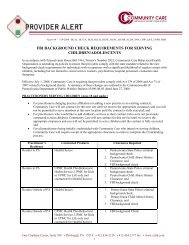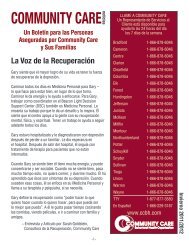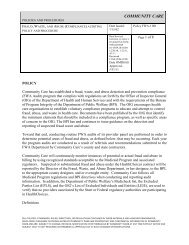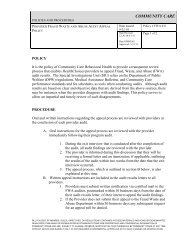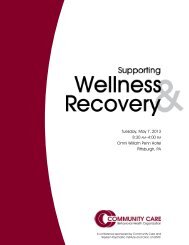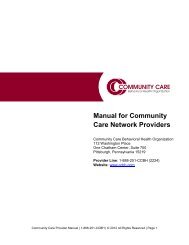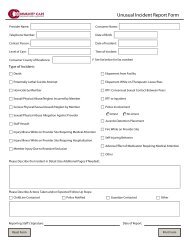Family Focused Solution Based - Community Care Behavioral Health
Family Focused Solution Based - Community Care Behavioral Health
Family Focused Solution Based - Community Care Behavioral Health
You also want an ePaper? Increase the reach of your titles
YUMPU automatically turns print PDFs into web optimized ePapers that Google loves.
PerformanceStandards<strong>Family</strong> <strong>Focused</strong> <strong>Solution</strong> <strong>Based</strong>Performance Standards are intended to provide a foundation and serve as a tool topromote continuous quality improvement and progression toward best practiceperformances, to increase the consistency of service delivery and to improveoutcomes for membersDisclaimer: These Performance Standards should not be interpreted as regulations. Entities providing services aspart of the <strong>Health</strong>Choices program must first be enrolled in the Pennsylvania Medical Assistance program as theappropriate provider type. Providers must then comply with all applicable Pennsylvania laws, including Title 55,General Provisions 1101, licensing program requirements and any contractual agreements made with <strong>Community</strong><strong>Care</strong> <strong>Behavioral</strong> <strong>Health</strong> Organization in order to be eligible for payment for services.© 2012 <strong>Community</strong> <strong>Care</strong> | 1-888-251-CCBH | Page 1
• FFSBS also serves families who are unable to participate in traditional outpatientservices.• Providers are expected to work closely with families and other involved systems toresolve safety issues that may be a barrier in service delivery or treatment progress.While there may be occasions in which safety concerns preclude a FFSBS teamfrom being able to provide services, the provider is expected to document allreasonable efforts to address this issue and the steps taken to assist the family inaccessing appropriate services.• Assessment of substance use and domestic violence for all family members must bedone at the point of referral and during the course of FFSBS to determine if, in fact,this level of care is generally appropriate. The FFSBS team is expected to discusssuch issues openly with family members, work to contract with families on conditionsof participation in the FFSBS, and offer to assist family members in accessing otherneeded services. Within the first several weeks of treatment and during the earlyengagement process, the FFSBS team is expected to make a determination as tothe appropriateness of the continuation of FFSBS and on the family’s ability to fullyparticipate.• After the initiation of services, any determination by the FFSBS program thatservices are not appropriate for a family must be made in a timely manner, andcommunicated to the family and referral source. The basis of the determination mustbe documented and communicated to the consulting physician or psychologist.• It is recognized that it may take a FFSBS team up to 30 days while renderingtreatment services to a family to reach a final determination about theappropriateness of this level of care to best meet the needs of the family. Likewise,families may decide during this early phase of treatment that FFSBS are notappropriate and may choose to discontinue services. The FFSBS team is expectedto share and openly discuss their assessments and recommendations regarding thecontinuation of services with families throughout the treatment process.Interagency Service Planning Team (ISPT) Meeting Process• FFSBS providers should utilize ISPT meetings as a tool to ensure coordination ofcare for families. Providers must convene, at a minimum, an initial ISPT meetingwithin 30 days of the initiation of services and convene a discharge planning meetingprior to the close of service. ISPT meetings should be used more frequently ifclinically indicated. Providers should plan for additional supportive resources whenneeded to enable families to fully participate in the ISPT meeting process (such aschildcare for young children).• Providers are responsible for ensuring that the core components of the ISPTmeeting process are addressed including:• CYF/JPO, as well as other agencies, systems, natural supports, and communityresources that the family wishes to include in the meeting, are formally invited toparticipate and clearly notified in advance of the meeting date, location, and time.The FFSBS team should also make phone contact with those invited to themeeting to begin to establish working relationships with members of theinteragency team. Meetings are scheduled at the family’s convenience both in© 2012 <strong>Community</strong> <strong>Care</strong> | 1-888-251-CCBH | Page 5
terms of time and location, with consideration given to promoting attendance bykey members of the interagency team.• The FFSBS team should discuss the ISPT meeting process with the family priorto the meeting, defining goals and ground rules for the meeting as well asdetermining with the family who will facilitate the meeting and how the team canbe most supportive of the family during the meeting. The roles of each of theparticipating FFSBS staff in the ISPT meeting should be clearly defined prior tothe meeting. In preparation, the FFSBS team may role play with the familyvarious conversations about sensitive issues that may occur during the ISPTmeeting. The family has the right to identify issues that are off limits fordiscussion in the ISPT meeting. The ISPT meeting process can be used tosupport families in the development of self-advocacy skills.• The ISPT meeting should follow a standardized agenda that addresses referralconcerns, strengths, and needs of the family. The agenda should support thefamily to talk early in the process. The development of treatment goals and/orprogress on goals should be addressed. The goal of preventing the need forinpatient care or other types of out-of-home services should be discussed at theISPT meeting. Modifications to the standardized agenda should be made toaccommodate the unique needs or characteristics of families.• The ISPT meeting is used as an opportunity for all involved systems and thefamily to develop and/or discuss treatment goals across systems and ensuresthat goals defined by various involved systems are as integrated as possible anddo not conflict. The meeting also establishes accountability of all those involvedin assisting the family in goal attainment.• During the development of goals, parents or primary caregivers should be giventhe opportunity to identify a goal that helps them to take care of themselves, inorder to be better able to support their family. This goal is to be integrated intothe overall treatment plan.• ISPT meetings should include a discussion of both formal and informal supports.Linkages to supports in a variety of settings including home, school, mentalhealth, social/recreational, and other systems should be explored for all familymembers. There should be significant exploration of natural and informalsupports as well. The ISPT meeting presents an opportunity for the team toidentify any obstacles to obtaining resources for the family.• The FFSBS team should give families the opportunity to debrief after an ISPTmeeting. The information from such a debriefing may be useful in planning for asubsequent ISPT meeting and creating a meeting environment that is supportiveof families. Documentation of this discussion should occur in progress notes andmember feedback should be reflected by how the subsequent ISPT meeting isfacilitated.• ISPT meeting participation is documented. FFSBS team should provide allattendees with documentation that summarizes the meeting, details what actionsare to be taken, target dates for completion of assigned tasks, and identifies whois responsible for completing each assigned task. The FFSBS team isresponsible for maintaining contact with members of the ISPT to ensure that allplanned interventions are being acted upon.© 2012 <strong>Community</strong> <strong>Care</strong> | 1-888-251-CCBH | Page 6
Crisis Planning• FFSBS services must be available 24 hours a day, seven days a week to providecrisis intervention services. FFSBS providers are expected to have policies in placeregarding processes for triaging family emergency calls and determining the mosteffective and therapeutic way to respond. All staff members are to be trained onsuch policies. Program supervisors are expected to monitor and review emergencyresponses and continually work to improve the effectiveness of this service.• Families should be provided with written material on how to access crisisintervention services at the initial contact with the FFSBS team. Any process FFSBSprograms develop to meet the expectation for 24 hours a day, seven days a weekavailability must result in a prompt response to a family’s request for help.Consistent, prompt responses must be evident from review of the charts of theprogram.• A primary goal of crisis planning is the prevention of the need for inpatient care orother out-of-home services or placements. When <strong>Community</strong> <strong>Care</strong> is notified by aninpatient provider that an individual currently receiving FFSBS is presenting forhospitalization, the inpatient provider will contact the FFSBS provider. <strong>Community</strong><strong>Care</strong> will then also contact the FFSBS provider. The FFSBS provider is expected tofully communicate with the inpatient provider and work to divert the hospitalization,when clinically appropriate. Ideally, a representative from the FFSBS programshould meet the family at the facility and support the family through the diversion.CYF/JPO will be notified of any safety factors to a child or adolescent, which mayresult in the need for placement. If CYF/JPO deems it necessary to place a child oradolescent, then <strong>Community</strong> <strong>Care</strong> is notified by the FFSBS service team.• FFSBS teams are expected to develop individualized crisis/safety plans with familiesat the initiation of services. Families should be asked to define what constitutescrises to them to ensure that the developed crisis plan is individualized. How familieshave previously responded to crises should be considered in the development of thecrisis plan. Crisis plans should include sufficient detail to enable families and team tofollow through with identified steps. Directions to the families’ home should beavailable to the FFSBS program to be proactive in the event that another programstaff member needs to respond to a crisis. Crisis plans should include theidentification of possible respite and transportation options to the family.• Crisis plans should be signed by the family and by the treating FFSBS team.• Crisis plans should be available to any staff within the FFSBS program that might becalled upon to respond to a crisis situation with the family.• Crisis plans should be attached to overall treatment plans and should be reviewedregularly (at a minimum of once a month) as are treatment plans. Crisis plans shouldalways be reviewed if an inpatient admission or out-of-home placement occurs.• Crisis plans should be shared with systems and service providers who may beinvolved with families being served by the FFSBS program. Crisis/safety plansshould identify all possible resources available to the family in the event of a crisis.Resources may include natural, family, and informal supports.• Crisis plans should address, at a minimum, identification of prior precipitants tocrises, delineation of interventions to address precipitants, a means of assessing the© 2012 <strong>Community</strong> <strong>Care</strong> | 1-888-251-CCBH | Page 7
outcome of the interventions, and specific alternatives to be tried prior toconsideration of inpatient treatment (given that the situation can be safely managedin current level of care).• A FFSBS team is expected to review the crisis plan with the family following crisissituations. The plan should be revised when clinically indicated.Treatment Planning Process and the Development of the Treatment Plan• FFSBS providers are expected to create a service delivery environment in which thefamily participates as a full partner of the treatment team in the development of thetreatment plan.• The service planning process is expected to identify initial priorities for services andestablish a progressive course for treatment. The team should do an immediatesafety risk assessment. An initial treatment plan, addressing the issues that put achild or adolescent at risk for out-of-home placement, should be developed at theinitiation of services. This plan should include a crisis/safety plan for the family.• The treatment plan should function as a living, usable document. It should be usedas a working map for what the team and family plan to achieve and how toaccomplish those goals. The plan should include family system information andpresent a comprehensive perspective of individual and family functioning.• The treatment plan is to be developed in collaboration with the family and isexpected to be completed within 30 days of the initiation of services. It shoulddemonstrate an integrated, well-collaborated approach to services across allinvolved systems. The treatment plan document serves as a “contract” between allinvolved parties regarding their responsibilities for the services to be rendered to thefamily. The treatment plan is to be updated with the family at least every 30 days.• With the family’s consent, all members of the ISPT should receive copies of thoseparts of the treatment plan relevant to their involvement with the family. With thepermission of the family/guardian, the plan should be shared with the school team,when appropriate, to ensure that behavioral interventions are consistent across allenvironments. The family should sign the treatment plan and receive a copy of thedocument.• Documentation of monthly treatment plan reviews must be maintained. Treatmentprogress should be reviewed weekly with the family. Such a review provides theopportunity to test that the treatment plan continues to be meaningful to the familyand that the goals are realistic and achievable. Rating progress weekly can also bevery useful in reviewing the effectiveness of current interventions and makingmodifications when clinically necessary. When progress is minimal, FFSBS teamsshould consider including the program supervisor in a discussion with the familywhile reviewing the treatment plan progress.• The service planning process and the resulting treatment plan should address thestrengths and needs of each family member and clearly define goals, objectives, andinterventions. The objectives need to identify the specific steps that are to be takento achieve the stated goals. Target dates for the completion of goals need to berealistic and projected for each goal. Establishing target dates is an effective way ofanticipating the length of stay at this level of care.© 2012 <strong>Community</strong> <strong>Care</strong> | 1-888-251-CCBH | Page 8
• Goals must be achievable and measurable goals must have realistic, practicalmeaning for families. Treatment plans are expected to be written in words that areunderstandable to families, avoiding behavioral health professional jargon.• The treatment plan should identify how services from several sources will becoordinated and integrated to best address the needs of the family. When multiplesystems are involved, the FFSBS team should discuss with the family the need forregularly scheduled ISPT meetings. The FFSBS team is responsible for conveningsuch meetings as frequently as necessary to ensure well coordinated servicedelivery.• Treatment plans must be individualized and comprehensive in nature. The planshould be inclusive of therapy goals, crisis planning goals, case management goals,and family support/advocacy goals. Case management and advocacy goals must bebalanced with treatment goals.• Establishing the primary goals for services is often difficult given the complex needsof the family in this level of care. A deliberate discussion of overall goals and thenarrowing to priority goals is an important step in the treatment planning process.FFSBS teams should assist the family in focusing on a few meaningful, attainablegoals for the episode of care. The identified goals should require services of theintensity of FFSBS. Having measurable goals to review also helps the familyrecognize their progress and therefore their readiness for discharge. Goals that canbe achieved at a less intense level of care can be identified through the dischargeplanning process.• Treatment plans should reflect building support systems and community linkages.FFSBS are always to be aimed at building family self-sufficiency and healthyinterdependency.• The crisis/safety plan should be considered as part of the treatment plan and shouldbe developed at the initiation of services.• The treatment planning process should prompt a discussion with the family toidentify discharge goals and to prepare for the transitioning out of the FFSBSprogram. While it is often difficult to balance engaging the family in treatment andpreparing for discharge, it is essential that FFSBS providers commit to discussingdischarge planning on a regular basis with the family. “How will we know when weare done?” “What will things look like?” “We are “done” when things look likethis___.” This should be part of an ongoing discussion.• Progress notes should be connected to the treatment plan and FFSBS activitiesmust be related to the goals of treatment.• The treatment plan has value as a tool in supervision. Teams are expected to reviewthe implementation of the treatment plan on a case-by-case level in supervision,evaluating the effectiveness of interventions and discussing implementation ofinterventions in the context of supervision.Service Delivery• FFSBS services are designed as a comprehensive service with the primary goal ofenabling the family to care for children in the home and reduce the need for out-of-© 2012 <strong>Community</strong> <strong>Care</strong> | 1-888-251-CCBH | Page 9
home placement. Related goals include strengthening the family, improving copingskills, and serving as an advocate.• Within the first five days of treatment, the FFSBS team works with the family toidentify the preliminary service goals, making sure to address any safety issues first.During the first month of services, the FFSBS team conducts various assessmentactivities and works very closely with the family to develop a comprehensivetreatment plan. Ongoing assessment activities to measure functioning improvementsare essential during the course of service delivery.• In addition to early assessment and treatment planning activities, a primary goal ofearly contacts with the family is to engage the family fully in treatment. FFSBSproviders are expected to try multiple interventions that support the families to fullyparticipate in services. Programs are expected to have a comprehensive orientationprocess for families to promote engagement.• <strong>Family</strong> systems theory, structural family therapy, solution focused techniques,cognitive behavioral therapy, and ongoing training and supervision are central to themodel of FFSBS. FFSBS programs are expected to utilize appropriate clinical andbehavioral interventions from various schools of thought.• FFSBS programs are expected to provide treatment services that includeassessment, crisis planning and intervention, therapy, and case managementsupport. Service linkage, coordination of care, and family support and advocacy arealso key components of FFSBS. Given the multiple types of services delivered inthis model and the complex needs of the family who is typically serviced, it isimperative that FFSBS providers attend to the balance of services delivered,ensuring that proper attention is given to treatment needs. FFSBS are also expectedto introduce innovative therapeutic activities in response to input from the family.• The treatment plan is to guide service delivery. Services rendered are to supportattainment of the identified goals. Documentation of service provision must clearlydemonstrate the interventions provided, the response to the interventions, therelatedness to the treatment plan, and progress toward goal attainment. A narrativedescription of the “session” is not adequate.• Documentation of therapy services provided should note the modality of treatment,the participants, the primary focus of the session, and identification of keyinterventions delivered in a detailed manner (such as working with subsystems ofthe family, use of reframing, circular questioning, behavioral managementinterventions, etc.).• The role of each of the team member working with any given family should be clearlyidentified within the team, with the family, and reflected on the treatment plan.• Team delivered services are a component of the FFSBS program; therefore effectivemanagement of the program must include the ongoing assessment and monitoringof the use of team delivered services at a family level as well as at a program level.The supervisors are responsible for ensuring that 20% of each team’s time is spentrendering team delivered services. Clinical discussion in supervision and during alltreatment planning activities should provide the basis as to how to mostappropriately manage this aspect of the FFSBS program.• The assessment of the family's needs and the treatment plan should be used as aguide in determining the intensity of service delivery. Given the variability in service© 2012 <strong>Community</strong> <strong>Care</strong> | 1-888-251-CCBH | Page 10
intensity, it is crucial that teams continually evaluate the appropriateness of theirinvolvement and ensure that a focus on the primary goals is maintained. Given the“permeable boundaries” of working in community settings, it is important that theoverall appropriateness of the team’s involvement be evaluated in supervision on aregular basis.• FFSBS is characterized by the expectation and ability to address the strengths andneeds of individual family members as well as the family as a unit. The team shouldexplore collaboratively with the family unit, the strengths, needs, and possibleservice linkages for each family member.• Individual work can be done with other family members as long as it is directly tied tothe identified member’s treatment goals. While FFSBS are child centered services,service delivery and treatment planning are always family driven.• The importance of supervision and its impact on the service delivery process cannotbe understated for this level of care. The inherent challenges in delivering servicesas a team should be an ongoing topic in supervision. Teams must be supported tomature in their ability to build upon each other’s strengths, establish their individualroles with the families they serve, and maximize the therapeutic impact of working asa team. FFSBS programs should allow for one supervisor for every four teams in theprogram. Supervision with each team is expected to occur weekly at a minimum.Documentation of all supervision sessions, including detailed information about thesupervisor’s interventions with the team, is to be maintained by supervisors andreviewed regularly by project directors. Maintaining a separate document of eachcase review conducted during supervision is ideal. Supervisors are expected toroutinely go out into the field with teams to directly observe their work with families,provide feedback to the team, and support the team to continually develop theirclinical skills.Coordination of <strong>Care</strong>• Due to the comprehensive nature of the FFSBS program and the case managementcomponent of the service, the team should function as the lead clinicians for themember. Providers should obtain as much information about what systems andproviders are involved with all family members and help ensure that all roles andboundaries are clarified. As stated earlier, the ISPT meeting process can be a usefultool in addressing any coordination of care issues. FFSBS providers should alsohelp to educate other systems about the role of the program to promote effectivecoordination of care.• While the family may sometimes not feel comfortable including others involved intheir care at an ISPT meeting, FFSBS providers are expected to explore this fear orconcern with the family and facilitate the strengthening of the family’s relationshipswith other systems when possible.• FFSBS providers must ensure that care is coordinated and service linkage on acase-by-case basis is provided with other involved systems including, but not limitedto:• Physical health, including contact with the PCP• Education/vocational systems© 2012 <strong>Community</strong> <strong>Care</strong> | 1-888-251-CCBH | Page 11
• Child protective services• Juvenile probation• Other behavioral health providers such as Intensive Case Management, drugand alcohol services, psychiatric evaluation, and medication monitoring, etc.When psychiatric services are being provided, it is imperative that the FFSBSproviders maintain communication with the treating psychiatrist. FFSBS teamsare expected to assist the family in monitoring adherence to the medicationregimen. FFSBS providers should encourage family members to seek psychiatricservices when it appears as if a family member has a disorder amenable topsychotropic intervention or is in need of more intensive psychiatric services.• In exceptional cases when FFSBS are delivered in combination with behavioralhealth rehabilitation services (BHRS), such as therapeutic staff support (TSS), or anin-home provider, the FFSBS treatment plan must clearly delineate the treatmentgoals of the BHRS and in-home provider. Attention must be given to not duplicatingservices unnecessarily and to ensuring that services are delivered in a wellcoordinated manner. FFSBS providers hold the responsibility for leading or providingclinical direction to the other providers when jointly serving families. Regularmeetings or discussions must occur between the providers to ensure thecoordination of care. Linkage agreements should be established to detail the natureof the working relationship between the entities, especially when a pattern of sharedcases is established.• FFSBS providers are expected to hold other involved service providers accountableby following up with those providers that are failing to provide interventions agreed toduring the ISPT meeting and the development of the comprehensive treatment plan.• FFSBS providers are expected to establish linkage agreements with other providersand child service system partners. Such linkage agreements are intended to bepractical documents that clarify expectations of each other. Linkages should bereviewed at least annually.Discharge Planning• Discussion about discharge planning and aftercare should begin as early as the firstday of treatment and discharge criteria are to be included in the development of theinitial 30 day treatment plan. Discharge planning should be revisited each time thetreatment plan is reviewed and a target discharge date must be identified. Targetdates are useful in helping to establish expectations regarding length of stay in theprogram.• An episode of FFSBS is defined as three to six months. <strong>Community</strong> <strong>Care</strong> expectsproviders to be diligent about managing utilization in terms of intensity and length ofstay at a case-by-case level. Utilization management should be discussed as aroutine part of supervision. A psychologist or professional advisor at <strong>Community</strong><strong>Care</strong> will review any requests for an extension beyond the six month limit.• FFSBS providers are expected to help families to understand the process ofpreparation for discharge in a number of ways. Providers should educate familiesabout the likelihood of their experiencing a “crisis” as the planned discharge dateapproaches. Providers should discuss with families the emotions associated with the© 2012 <strong>Community</strong> <strong>Care</strong> | 1-888-251-CCBH | Page 12
“letting go” process, recognizing that due to the fact that services are intense andare delivered in the families’ homes, the working relationships between families andthe FFSBS staff are often intense. FFSBS providers may also use “transitionsessions” of less frequency to help families prepare for discharge. FFSBS arerequired to maintain at least weekly contact with the families during this transitiontime. FFSBS will utilize titration of services prior to discharge as a means for testingtreatment gains and sustainability of gains once discharged from the program.“Graduation celebrations” or rituals are often useful to families and staff in preparingfor discharge.• There will be occasions when FFSBS are not meeting the needs of the family andservices will be terminated by the provider or by the family. In such situations, theFFSBS provider is expected to frame the decision positively for the family and assistthe family in exploring other service options.• An ISPT meeting must be held prior to discharge. The referral source and/or theappropriate administrative case management program are to be notified of theclosing of FFSBS.• Providers are expected to link families with aftercare providers and assist in thesuccessful transition to those services. Providers are expected to facilitate thetransition to other levels of care to ensure continuity of care and follow up.• Requests for extensions beyond six months must be based on clinical rationale aspresented by the team and the team’s psychologist/ psychiatrist. In addition,<strong>Community</strong> <strong>Care</strong> may review all requests for an extension internally with apsychologist or physician (referred to as professional advisors) before rendering aservice determination decision.• <strong>Community</strong> <strong>Care</strong> will consider requests for “booster shots” or the short-termresumption (generally up to two weeks) of services to a family discharged within thepast year from FFSBS. This approach is appropriate when attempting to prevent aninpatient episode of care. It can also be very helpful in strengthening theimplementation of the aftercare plan or modifying the aftercare plan to better meetthe needs of the family. <strong>Community</strong> <strong>Care</strong> is amenable to recommendations from theprovider as to the needed intensity of duration of “booster shots.” Providers mayalso include planned “booster shots” in the discharge planning process to assistfamilies during transition times (such as the anniversary of a loss). FFSBS providersshould always consult with the current lead treatment provider, before initiating a“booster shot.”Cultural Competency• FFSBS providers are expected to support the ongoing development of culturalcompetence within their programs. Supervisors should make cultural competence anon-going topic of discussion with their teams.• Cultural Competency will be addressed in the FFSBS training curriculum.• FFSBS programs take the philosophical approach of learning from the familiesserviced, identifying strengths and recognizing the uniqueness of each family.Providers should engage in open, respectful communication about culturally basedvalues and belief systems before intervening.© 2012 <strong>Community</strong> <strong>Care</strong> | 1-888-251-CCBH | Page 13
• Providers are expected to maintain documentation of all initiatives to further developthe cultural competence and sensitivity of staff and programs. Some of the ways toassess the cultural competence of a program is through family satisfaction surveysand/or member complaints.Outcomes• FFSBS providers are expected to have an outcomes measurement program,consistent with their agency-wide continuous quality improvement plan.• FFSBS providers are expected, at a minimum, to gather family satisfaction data onat least an annual basis and demonstrate quality improvement initiatives in responseto the survey results.• Providers are expected to administer a standardized functional assessment (GAFscores, Columbia Impairment Scale, North Carolina <strong>Family</strong> Assessment Scale,CAFAS, or Los Angeles <strong>Family</strong> Assessment) to analyze the impact of services.• Providers are expected to have outcomes related to child safety, permanency, andwell-being.© 2012 <strong>Community</strong> <strong>Care</strong> | 1-888-251-CCBH | Page 14



